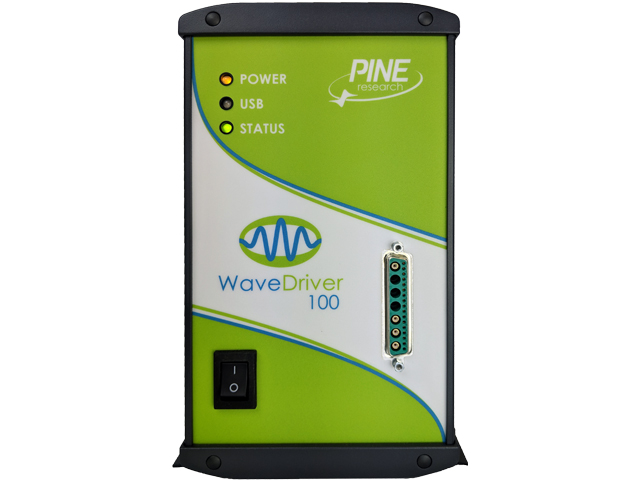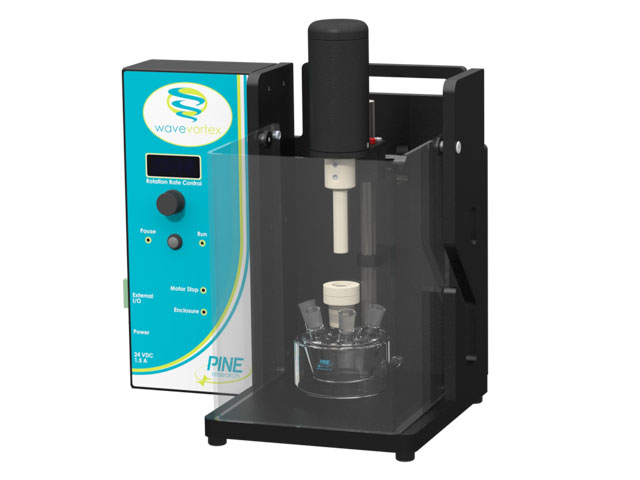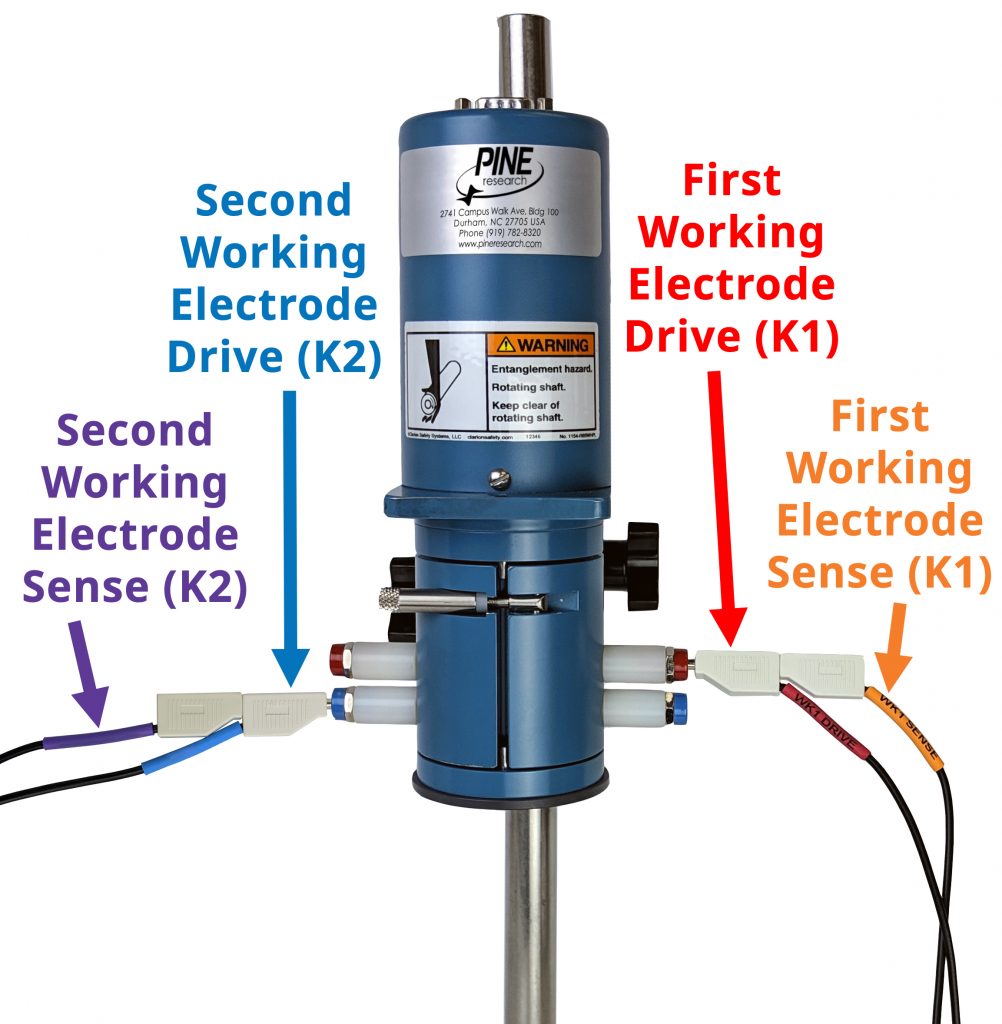Rotating Ring-Disk Electrode Setups (RRDE)
Last Updated: 5/29/19 by Neil Spinner
1Potentiostat RRDE Setups
A rotating ring-disk electrode (RRDE) cell contains a total of four electrodes – two working electrodes (disk and ring), one counter electrode, and one reference electrode. During an RRDE experiment, the potentiostat being used operates as a bipotentiostat, measuring the currents at the disk and ring electrodes (charge flows between the ring, the disk, and the counter electrode) while simultaneously measuring the potentials of the disk and ring electrodes with respect to the single reference electrode. This also implies that any potentiostat possessing only a single working electrode channel (e.g., the WaveDriver 100)
 WaveDriver 100 EIS Potentiostat
cannot be used to perform RRDE experiments.
WaveDriver 100 EIS Potentiostat
cannot be used to perform RRDE experiments.
 WaveDriver 100 EIS Potentiostat
cannot be used to perform RRDE experiments.
WaveDriver 100 EIS Potentiostat
cannot be used to perform RRDE experiments.In an RRDE experiment, the counter and reference electrode connections are made in the same manner as for three-electrode cells.
 Three-Electrode Setups
For a WaveDriver model potentiostat cell cable, the GREEN lead (counter electrode drive) is connected to the counter electrode, and the WHITE lead (reference electrode sense) is connected to the reference electrode.
Three-Electrode Setups
For a WaveDriver model potentiostat cell cable, the GREEN lead (counter electrode drive) is connected to the counter electrode, and the WHITE lead (reference electrode sense) is connected to the reference electrode.
The exact details for connecting the first and second working electrode signal lines to the disk and ring depend upon the particular electrode rotator being used. There are typically one or more brushes that contact the disk electrode and also one or more additional brushes that separately contact the ring electrode.
As an example of how to connect to an RRDE, consider the brush contacts on the Pine Research WaveVortex 10
 WaveVortex 10 Electrode Rotator
Rotator system (see Figure 1). This rotator system features two brushes (one for each electrode) which are connected to banana jacks on the motor unit. The RED and ORANGE cell cable leads (first working electrode drive and sense) should be stacked together and connected to the disk electrode using the RED banana jack on the motor unit. The BLUE and VIOLET cell cable leads (second working electrode drive and sense) should be stacked together and connected to the ring electrode using the BLUE banana jack on the motor unit.
WaveVortex 10 Electrode Rotator
Rotator system (see Figure 1). This rotator system features two brushes (one for each electrode) which are connected to banana jacks on the motor unit. The RED and ORANGE cell cable leads (first working electrode drive and sense) should be stacked together and connected to the disk electrode using the RED banana jack on the motor unit. The BLUE and VIOLET cell cable leads (second working electrode drive and sense) should be stacked together and connected to the ring electrode using the BLUE banana jack on the motor unit.
 WaveVortex 10 Electrode Rotator
Rotator system (see Figure 1). This rotator system features two brushes (one for each electrode) which are connected to banana jacks on the motor unit. The RED and ORANGE cell cable leads (first working electrode drive and sense) should be stacked together and connected to the disk electrode using the RED banana jack on the motor unit. The BLUE and VIOLET cell cable leads (second working electrode drive and sense) should be stacked together and connected to the ring electrode using the BLUE banana jack on the motor unit.
WaveVortex 10 Electrode Rotator
Rotator system (see Figure 1). This rotator system features two brushes (one for each electrode) which are connected to banana jacks on the motor unit. The RED and ORANGE cell cable leads (first working electrode drive and sense) should be stacked together and connected to the disk electrode using the RED banana jack on the motor unit. The BLUE and VIOLET cell cable leads (second working electrode drive and sense) should be stacked together and connected to the ring electrode using the BLUE banana jack on the motor unit.
Figure 1. WaveVortex 10 Electrode Connections for a Rotating Ring-Disk Electrode (RRDE)
A second example of RRDE connections is shown in Figure 2 for the popular Pine Research MSR rotator.
 Modulated Speed Rotator (MSR)
Similarly to with the WaveVortex 10, the RED and ORANGE cell cable leads (first working electrode drive and sense) should be stacked together and connected to the disk electrode using either of the top RED banana jacks on the motor unit. The BLUE and VIOLET cell cable leads (second working electrode drive and sense) should be stacked together and connected to the ring electrode using either of the bottom BLUE banana jacks on the motor unit. Additionally, for either or both the disk/ring electrodes, short banana cables may be used to connect the opposing RED or BLUE brush contacts together (see Figure 1 in the post on RDE and RCE setups
Modulated Speed Rotator (MSR)
Similarly to with the WaveVortex 10, the RED and ORANGE cell cable leads (first working electrode drive and sense) should be stacked together and connected to the disk electrode using either of the top RED banana jacks on the motor unit. The BLUE and VIOLET cell cable leads (second working electrode drive and sense) should be stacked together and connected to the ring electrode using either of the bottom BLUE banana jacks on the motor unit. Additionally, for either or both the disk/ring electrodes, short banana cables may be used to connect the opposing RED or BLUE brush contacts together (see Figure 1 in the post on RDE and RCE setups
 Rotating Disk and Rotating Cylinder Electrode Setups (RDE and RCE)
for example of this practice). This practice may or may not improve the signal-to-noise ratio of the experimental data; some trial-and-error is normally required to determine optimal cable configuration.
Rotating Disk and Rotating Cylinder Electrode Setups (RDE and RCE)
for example of this practice). This practice may or may not improve the signal-to-noise ratio of the experimental data; some trial-and-error is normally required to determine optimal cable configuration.
 Modulated Speed Rotator (MSR)
Similarly to with the WaveVortex 10, the RED and ORANGE cell cable leads (first working electrode drive and sense) should be stacked together and connected to the disk electrode using either of the top RED banana jacks on the motor unit. The BLUE and VIOLET cell cable leads (second working electrode drive and sense) should be stacked together and connected to the ring electrode using either of the bottom BLUE banana jacks on the motor unit. Additionally, for either or both the disk/ring electrodes, short banana cables may be used to connect the opposing RED or BLUE brush contacts together (see Figure 1 in the post on RDE and RCE setups
Modulated Speed Rotator (MSR)
Similarly to with the WaveVortex 10, the RED and ORANGE cell cable leads (first working electrode drive and sense) should be stacked together and connected to the disk electrode using either of the top RED banana jacks on the motor unit. The BLUE and VIOLET cell cable leads (second working electrode drive and sense) should be stacked together and connected to the ring electrode using either of the bottom BLUE banana jacks on the motor unit. Additionally, for either or both the disk/ring electrodes, short banana cables may be used to connect the opposing RED or BLUE brush contacts together (see Figure 1 in the post on RDE and RCE setups

Figure 2. MSR Rotator Electrode Connections for a Rotating Ring-Disk Electrode (RRDE)



